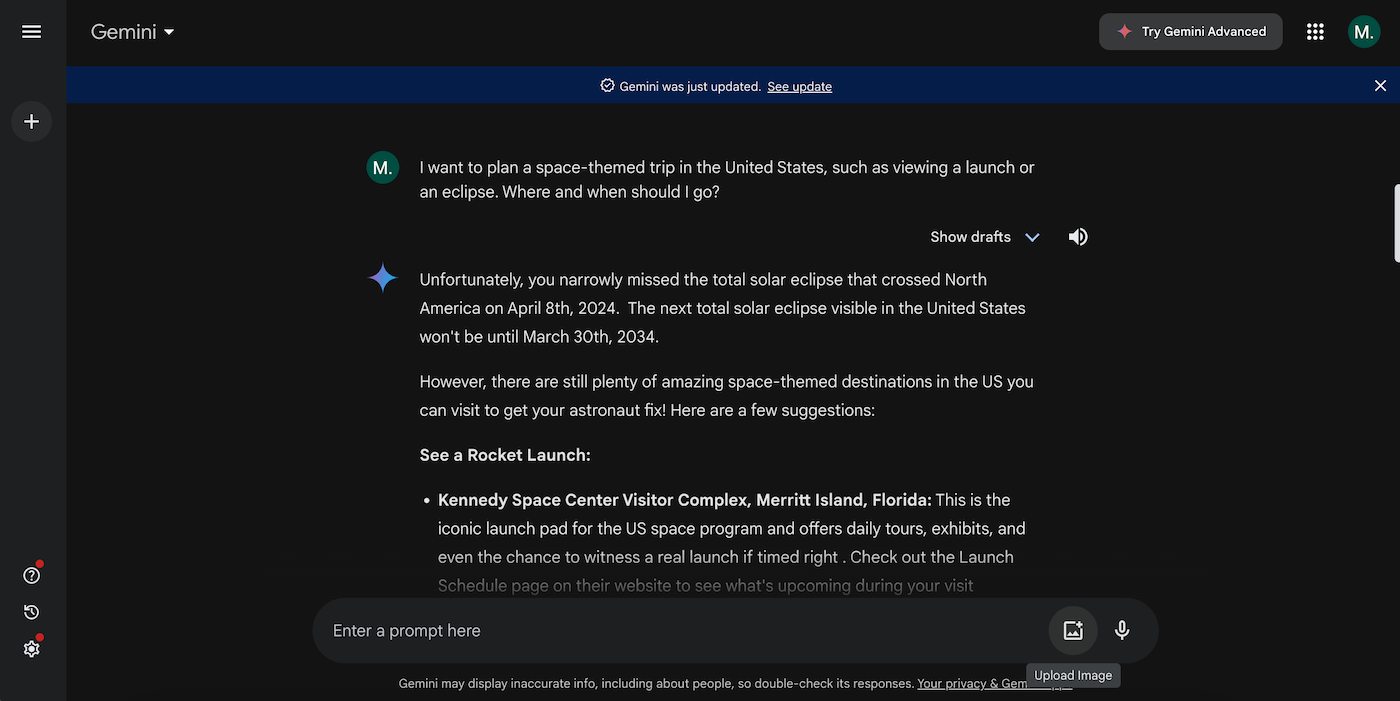With the proliferation of generative AI, it can be difficult to tell which, if any, of these AI assistants for coding and creative work are right for your business. Two of the major AI assistants are Google Gemini (formerly Bard) and Anthropic’s Claude.ai.
This article compares the core capabilities of the two AI assistants, both of which are free as of July 2024. To use Gemini, you must sign in with a Google account. To use Claude, you must sign in either with a Google account or an email address. In either case, if you use a Google Workspace account, you should check with your administrator to make sure access is allowed.
- Google Gemini: Best for providing up-to-date information.
- Anthropic Claude: Best for analyzing large amounts of content.
What is Google Gemini?
Gemini is an experimental conversational AI system designed by Google. As a large language model, Gemini can generate responses of text, code and other content in response to an entered prompt or image. Google launched Gemini (as Bard) in the first quarter of 2023. In February 2024, Google renamed Bard to Gemini to reflect that users could access a family of AI models, not just a single chatbot, through the same brand name.
What is Claude.ai?
Claude.ai is a public-facing beta of Anthropic’s conversational AI system. It was launched at the same time as when the company announced Claude 2 in mid-2023. Since then, Claude.ai has been updated to the latest version of Anthropic’s model, Claude 3.5 Sonnet. Anthropic has emphasized its efforts to design Claude with an emphasis on AI safety.
Gemini vs Claude: Comparison table
The chart below highlights the major differences between Google’s Gemini and Anthropic’s Claude.
| Feature | ||
|---|---|---|
| Made by | ||
| Available countries | ||
| Language support | ||
| Coding support | ||
| Connects to the internet for up-to-date information | ||
| Accepts image upload | ||
| Accepts text file upload | ||
| Context window* | ||
| Export options | ||
The context window determines the length of content the system can retain and respond to at once. Put simply, if you exceed the limit, the system may provide a response that indicates a lack of “retention” or “understanding” of content beyond the window. A long window makes the analysis of long documents possible.
Gemini vs Claude pricing
Gemini and Claude.ai are free to use. Anthropic offers paid Pro and Team plans on Claude.ai with multiple seats and higher rate limits. Pro costs $20 per user per month, while Team costs $25 per user per month. Google offers Gemini Advanced, which lets Gemini interface directly with Gmail and Docs and adds 2 TB of storage. You can access Gemini Advanced through a Google One AI Premium subscription, which costs $19.99.
The most notable competitor to these two systems, ChatGPT from OpenAI, offers both a free edition and a more capable edition for an upgrade of $20 per month.
Google and Anthropic seek to serve enterprise and developer AI needs as well. Google offers a wide range of AI and machine learning systems, while Anthropic offers access to distinct editions of Claude, each optimized for different situations and price points.
Feature comparison: Google Gemini vs Claude.ai
Conversational chat
Both Gemini and Claude operate as conventional AI chatbots: You type a prompt, and the system replies with a response. As conversational chat systems, they let you reference prior prompts in a chat. For example, if your first prompt is a request to summarize a book:
Can you summarize the key recommendations in the book “Power and Progress: Our Thousand-Year Struggle Over Technology & Prosperity”?
A later query in the chat conversation with the intent to learn the authors might be:
Who wrote it?
The system should accurately understand that “it” refers to the book and “who” refers to the authors. Contrast that with a legacy search, where a summary of key points is simply not feasible and where you would need to combine everything into one keyword search query just to learn the authors.
The one significant difference between the two systems is that Claude supports a much longer context window than Gemini. The result is that Claude can work with longer texts and also allows a more extended conversation about a topic than Gemini.
Write text
Gemini and Claude work well when you want the system to generate text. For example, you can ask either system to write text you need for pretty much any purpose, such as an email, marketing copy, a cover letter or a blog post. Specify in as much detail as possible the contents, length and type of text you want, and both systems will tend to produce usable text. Not happy with the result? Describe exactly how you need the tone, content, length or structure of the text revised, and ask Gemini or Claude to try again.
Generate suggestions
Gemini and Claude excel when you seek suggestions. Ask either chatbot for lists of things you want to learn about, explore or read, and you’ll likely receive at least a few relevant items. If you have examples, include them to provide context and nudge the system toward a more relevant response.
Remember, both of these systems may provide information that is inaccurate, misleading or simply wrong, so you may need to verify the content for accuracy.
SEE: Hiring Kit: Prompt Engineer (TechRepublic Premium)
Claude.ai: Pros and cons
Claude’s distinctive strength is its ability to work with long text files, thanks to the system’s significantly long context window. You may upload as many as five files of up to 10MB each, along with your message.
For example, you might upload one or more sample technology plans, guides or strategy documents. Once shared, you could then explore various details within those documents with Claude. Alternatively, you might provide Claude with relevant details about a different organization or client and ask the system to write a new plan, drawing from the prior example plans you had uploaded.
Furthermore, in October, Anthropic released an updated version of Claude Sonnet 3.5 with a “Computer Use” capability. The API can translate text prompts into computer commands such as cursor movements, button clicks, and typed text, turning it into a model that’s more like an autonomous AI agent than a chatbot.

Pros of Claude
- Excellent long document capabilities (due to the long context window of 200k+ tokens or about 500 pages of text with Claude Pro).
- May upload up to five files of up to 10MB each as part of a prompt.
- Extensive support for coding/programming languages.
- “Computer Use’ API.
Cons of Claude
- No access to internet search.
Google Gemini: Pros and cons
Gemini’s ability to access the internet and accept image input sets the system apart from Claude. Gemini can leverage search to incorporate recent news, weather and other information into responses, unlike some large language models that lack access to information after a defined date. In many cases, this allows Gemini to provide up-to-date data in responses, with a sample prompt about an event that occurred within the prior month. Additionally, since Gemini incorporates many image capabilities previously launched in Google Lens, you may upload a JPEG, PNG or WebP file and then chat about the image content. (Gemini’s image capabilities are available initially only when used in English.)

Pros of Gemini
- Accessible in many languages.
- Internet search.
- Built-in export to Gmail, Google Docs and public sharing.
Cons of Gemini
- Lacks support for file uploads.
- Limited context window compared to Claude.ai.
Should you use Gemini or Claude?
Gemini and Claude represent state-of-the-art conversational AI systems with rapidly evolving capabilities. Either system is an excellent option when you want to experiment with a generative AI tool.
However, Gemini is clearly the best when your chat requires internet access or image support, while Claude is clearly the better option when your chat might benefit from uploaded documents or long conversational context.
Experiment with both AI systems to become familiar with their capabilities, and then select the chatbot that is most able to help you accomplish a specific task.
Methodology
This comparison relied on detailed reviews of announcements from each vendor, experimentation with each system and manual testing of specific features publicly available between July 2023 and June 2024. Since both companies are adding capabilities fairly often, you may want to check the latest Google Gemini updates or Anthropic announcements to learn of more recently added features.
Editor’s note: This article was updated by Megan Crouse.
